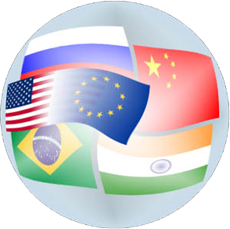Globalization’s 21st Century Makeover explains how “emerging” market companies are rapidly becoming global players—to whit, new owners for Jaguar and Land Rover.
 Emerging countries have long been regarded by globalizers as targets for exploitation, but 21st century market forces are turning legacy thinking on its head, which produces disruption and its sibling, opportunity.
Emerging countries have long been regarded by globalizers as targets for exploitation, but 21st century market forces are turning legacy thinking on its head, which produces disruption and its sibling, opportunity.
The conventional thinking goes that emerging countries like Brazil, Russia, India and China (BRIC) have talented knowledge/human capital resources that can be tapped in outsourcing and offshoring arrangements. Moreover, these workers’ employment in high value knowledge jobs creates a new consumer class among large populations. Emerging countries’ rapidly growing consumer markets stand in sharp contrast to developed countries’, which are flat or shrinking. China and India have been relaxing restrictions on foreign ownership, which has increased FDI, especially in China, enabling foreign companies to invest in and buy BRIC companies.
However, the big story in 2007 was the opposite:
Companies in emerging markets are acquiring rich country assets in record numbers. For example, see KPMG’s study, “Emerging markets closing the gap on developed countries in the race for international acquisitions,” which compares “inbound” (rich country companies acquiring emerging country assets) with “outbound” (emerging country companies acquiring rich country assets) and finds them moving towards parity.
Another Take on Jaguar/Land Rover/Tata Motors
A current high-profile case that you should follow closely is Tata Motors’ imminent acquisition of Jaguar and Land Rover from Ford. Many lambaste the deal because they cannot understand how Tata Motors thinks it can wring value out of Jaguar and Land Rover when Ford could not, after many years of effort. Although Ford has admittedly not been a stellar performer of late, it does know the automotive business, and it has failed to operate Jaguar and Land Rover profitably since acquiring them in 1990 and 2000 respectively. Notably, their former owners had profit issues, too. Of course, naysayers assume that Tata will want to shift production to low-cost India resources, but they completely miss the point.
The real upside for Tata would be to leverage the storied brands to address India’s rapidly growing luxury market, as India currently has no native luxury car brand. I doubt that Tata could significantly improve either brand’s performance in existing markets, especially because they would have to do significant deals with unions, which would tie their hands in the near term, preventing substantial change. Did you know that India now has the ninth largest millionaire population in the world? Moreover, India’s millionaire growth rate is only second to South Korea’s (see 11th Annual World Wealth Report).
This trend represents a fundamental redefinition of “globalization,” which has long been imbued with an imperialist flavor. As I wrote in The TransAtlantic Partnership and its Implications for U.S. and E.U. Economies, rich (i.e. “developed”) countries will increasingly share the stage with “emerging” countries. Global capital flows mean that wealth will redefine legacy ways of thinking, yielding unprecedented threat and opportunity.

Leave a Reply
You must be logged in to post a comment.